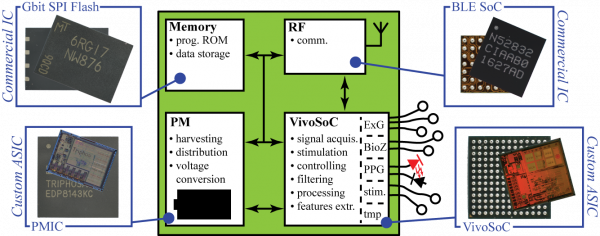Difference between revisions of "Enabling Standalone Operation"
From iis-projects
| Line 3: | Line 3: | ||
A key feature of our biomedical acquisition and processing platform is standalone operation: The system must be able to provide all required supply voltages and clock frequencies without external components. Furthermore, the three involved uControllers (PULP, pulpino and a commercial radio SoC) must load their program code from non-volatile storage at startup once all supplies and clocks are ready. The commercial radio SoC has integrated flash memory for this purpose; our two own ASICs share the discrete multi-Gigabit NAND flash that is also used for data storage. | A key feature of our biomedical acquisition and processing platform is standalone operation: The system must be able to provide all required supply voltages and clock frequencies without external components. Furthermore, the three involved uControllers (PULP, pulpino and a commercial radio SoC) must load their program code from non-volatile storage at startup once all supplies and clocks are ready. The commercial radio SoC has integrated flash memory for this purpose; our two own ASICs share the discrete multi-Gigabit NAND flash that is also used for data storage. | ||
| − | We have all the key requirements for standalone operation in place (programmable voltage converters, oscillators and boot loaders); in this project you are going to put them all together. The goal is to demonstrate startup and operation of the platform with only a Li-ion connected. | + | We have all the key requirements for standalone operation in place (programmable voltage converters, oscillators and boot loaders); in this project you are going to put them all together and create the missing control software/firmware. The goal is to demonstrate startup and operation of the platform with only a Li-ion connected. |
| + | |||
| + | In this thesis you will learn: | ||
| + | *Firmware management in multi-chip systems | ||
| + | *Details and challenges of bootloaders/boot binaries | ||
| + | *Startup and synchronization challenges of complex embedded systems | ||
| + | |||
| + | |||
| + | ===Status: Available === | ||
| + | We are looking for 1-2 motivated Semester Thesis/Group Work students <br> | ||
| + | Contact: [[:User:Glaserf | Florian Glaser]] | ||
| + | |||
| + | ===Prerequisites=== | ||
| + | *Some experience with embedded/low level software | ||
| + | *Interest in embedded systems and uControllers | ||
| + | |||
| + | <!-- | ||
| + | ===Status: Completed === | ||
| + | : Fall Semester 2014 (sem13h2) | ||
| + | : Matthias Baer, Renzo Andri | ||
| + | ---> | ||
| + | |||
| + | <!-- | ||
| + | ===Status: In Progress === | ||
| + | : Student A, StudentB | ||
| + | : Supervision: [[:User:Belfanti | Sandro Belfanti]] | ||
| + | ---> | ||
| + | |||
| + | ===Character=== | ||
| + | *20% Concept | ||
| + | *40% Embedded software design | ||
| + | *40% Experiments/Measurements | ||
[[Category:Digital]] | [[Category:Digital]] | ||
| Line 11: | Line 42: | ||
[[Category:Available]] | [[Category:Available]] | ||
[[Category:Glaserf]] | [[Category:Glaserf]] | ||
| − | |||
[[Category:PULP]] | [[Category:PULP]] | ||
[[Category:Software]] | [[Category:Software]] | ||
[[Category:Processor]] | [[Category:Processor]] | ||
[[Category:Biomedical System on Chips]] | [[Category:Biomedical System on Chips]] | ||
Revision as of 17:50, 22 May 2018
A key feature of our biomedical acquisition and processing platform is standalone operation: The system must be able to provide all required supply voltages and clock frequencies without external components. Furthermore, the three involved uControllers (PULP, pulpino and a commercial radio SoC) must load their program code from non-volatile storage at startup once all supplies and clocks are ready. The commercial radio SoC has integrated flash memory for this purpose; our two own ASICs share the discrete multi-Gigabit NAND flash that is also used for data storage.
We have all the key requirements for standalone operation in place (programmable voltage converters, oscillators and boot loaders); in this project you are going to put them all together and create the missing control software/firmware. The goal is to demonstrate startup and operation of the platform with only a Li-ion connected.
In this thesis you will learn:
- Firmware management in multi-chip systems
- Details and challenges of bootloaders/boot binaries
- Startup and synchronization challenges of complex embedded systems
Status: Available
We are looking for 1-2 motivated Semester Thesis/Group Work students
Contact: Florian Glaser
Prerequisites
- Some experience with embedded/low level software
- Interest in embedded systems and uControllers
Character
- 20% Concept
- 40% Embedded software design
- 40% Experiments/Measurements
